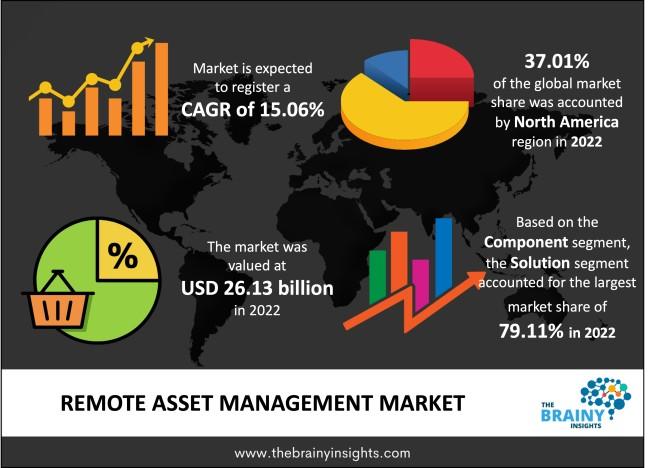
📊 Market Overview
The global remote asset management market was valued at USD 26.13 billion in 2022 and is projected to grow at a CAGR of 15.06% from 2023 to 2032, reaching approximately USD 106.26 billion by 2032. This growth is driven by the increasing adoption of IoT, AI, and cloud technologies across various industries seeking real-time monitoring and predictive maintenance solutions.
🔄 Market Dynamics
Drivers
- Real-Time Monitoring & Predictive Maintenance: Organizations are leveraging real-time data analytics to monitor asset performance, enabling proactive maintenance and reducing downtime.
- IoT and Cloud Integration: The integration of IoT devices and cloud platforms facilitates seamless data collection and analysis, enhancing asset visibility and control.
- Industry 4.0 Initiatives: The push towards digital transformation in manufacturing and other sectors is propelling the demand for advanced asset management solutions.
Challenges
- Data Security Concerns: As RAM systems handle sensitive operational data, ensuring cybersecurity and data privacy remains a significant challenge.
- High Implementation Costs: The initial investment required for deploying RAM solutions can be substantial, potentially hindering adoption, especially among SMEs.
🌍 Regional Analysis
- North America: Leading the market with a 35% share in 2023, driven by advanced technological infrastructure and early adoption of IoT solutions.
- Europe: Holding a 30% market share, Europe's growth is fueled by digital transformation initiatives and a strong focus on sustainability and efficient asset utilization.
- Asia-Pacific: The fastest-growing region, with a 25% share in 2023, attributed to rapid industrialization, increasing IoT adoption, and significant investments in digital technologies.
🧩 Segmental Analysis
By Component
- Solutions: Including real-time location systems, analytics and reporting, asset performance management, surveillance and security, network bandwidth management, and mobile workforce management.
- Services: Comprising professional services (consulting, implementation, support and maintenance) and managed services.
By Asset Type
- Fixed Assets: Such as machinery and infrastructure.
- Mobile Assets: Including vehicles and portable equipment.
By Deployment Mode
- Cloud-Based: Offering scalability and remote accessibility.
- On-Premises: Providing enhanced control and security.
By Organization Size
- Large Enterprises: With significant investments in advanced asset management solutions.
- Small and Medium-Sized Enterprises (SMEs): Increasingly adopting RAM solutions to enhance operational efficiency.
By Industry Vertical
- Manufacturing: Leading the market with a 32% share in 2023.
- Transportation and Logistics: Accounting for 25% of the market, driven by the need for real-time tracking and fleet management.
- Healthcare: The fastest-growing application, fueled by the rising demand for remote monitoring and asset tracking in medical facilities.
- Energy and Utilities, Retail, and Smart Grids: Also, significant contributors to market growth.
📘 Request PDF Brochure: https://www.thebrainyinsights.com/enquiry/sample-request/12635
🏢 Key Players
Prominent companies operating in the Remote Asset Management market include:
- Siemens AG
- Cisco Systems Inc.
- AT&T Inc.
- Hitachi Ltd.
- Schneider Electric SE
- Infosys Limited
- PTC Inc.
- IBM Corporation
- SAP SE
- Rockwell Automation Inc.
- Verizon Communications Inc.
These companies are focusing on strategic partnerships, mergers and acquisitions, and product innovations to strengthen their market position.
🔍 Key Trends
- Integration of AI and Machine Learning: Enhancing predictive maintenance capabilities and operational efficiency.
- Adoption of Digital Twins: Enabling virtual replication of physical assets for better monitoring and analysis.
- Edge Computing: Facilitating real-time data processing closer to the asset location, reducing latency.
- Focus on Sustainability: Companies are increasingly adopting RAM solutions to optimize resource utilization and reduce environmental impact.
✅ Conclusion
The Remote Asset Management market is poised for significant growth, driven by technological advancements and the increasing need for efficient asset monitoring and maintenance across various industries. While challenges such as data security and high implementation costs persist, the integration of AI, IoT, and cloud technologies presents substantial opportunities for innovation and market expansion. Organizations that invest in robust and secure RAM solutions are likely to gain a competitive edge in the evolving digital landscape.
For Further Information:
